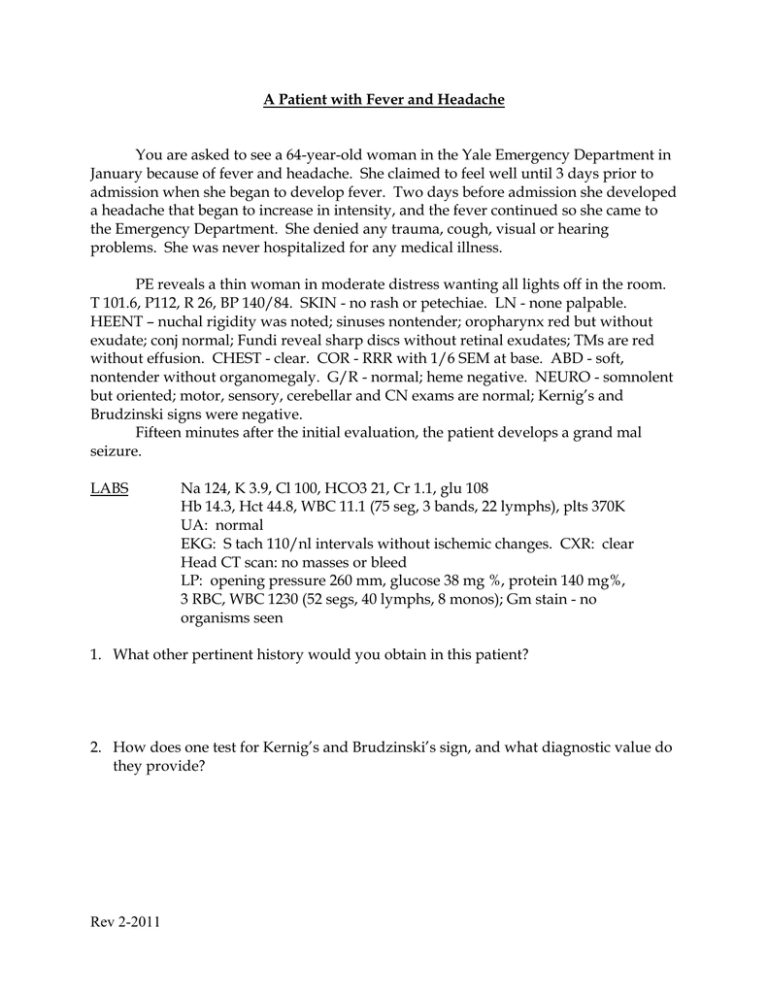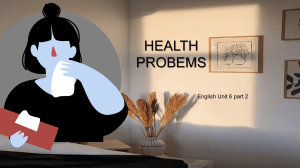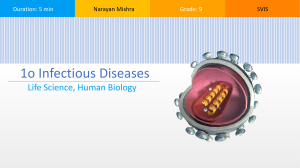Patient with fever and headache
advertisement

A Patient with Fever and Headache You are asked to see a 64-year-old woman in the Yale Emergency Department in January because of fever and headache. She claimed to feel well until 3 days prior to admission when she began to develop fever. Two days before admission she developed a headache that began to increase in intensity, and the fever continued so she came to the Emergency Department. She denied any trauma, cough, visual or hearing problems. She was never hospitalized for any medical illness. PE reveals a thin woman in moderate distress wanting all lights off in the room. T 101.6, P112, R 26, BP 140/84. SKIN - no rash or petechiae. LN - none palpable. HEENT – nuchal rigidity was noted; sinuses nontender; oropharynx red but without exudate; conj normal; Fundi reveal sharp discs without retinal exudates; TMs are red without effusion. CHEST - clear. COR - RRR with 1/6 SEM at base. ABD - soft, nontender without organomegaly. G/R - normal; heme negative. NEURO - somnolent but oriented; motor, sensory, cerebellar and CN exams are normal; Kernig’s and Brudzinski signs were negative. Fifteen minutes after the initial evaluation, the patient develops a grand mal seizure. LABS Na 124, K 3.9, Cl 100, HCO3 21, Cr 1.1, glu 108 Hb 14.3, Hct 44.8, WBC 11.1 (75 seg, 3 bands, 22 lymphs), plts 370K UA: normal EKG: S tach 110/nl intervals without ischemic changes. CXR: clear Head CT scan: no masses or bleed LP: opening pressure 260 mm, glucose 38 mg %, protein 140 mg%, 3 RBC, WBC 1230 (52 segs, 40 lymphs, 8 monos); Gm stain - no organisms seen 1. What other pertinent history would you obtain in this patient? 2. How does one test for Kernig’s and Brudzinski’s sign, and what diagnostic value do they provide? Rev 2-2011 3. What are the advantages and disadvantages with obtaining a head CT scan before lumbar puncture in this patient? Would you have ordered one? 4. What categories of infectious agents would you be most concerned about? 5. Are there non-infectious diseases that can produce a similar CSF profile? 6. What specific diagnostic studies would you consider at this time? . 7. What empiric therapy would you select for this patient in the Emergency Department? 8. 24 hours later, the blood and CSF cultures grow out Gram positive cocci in pairs and chains. The patient’s husband asks you what the patient’s chances are of surviving without any neurological problems. How do you respond? Rev 2-2011








